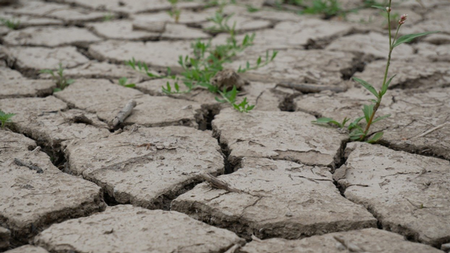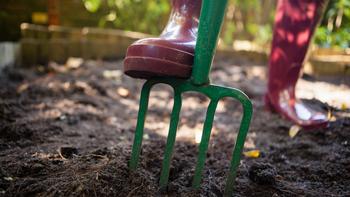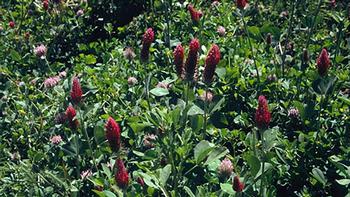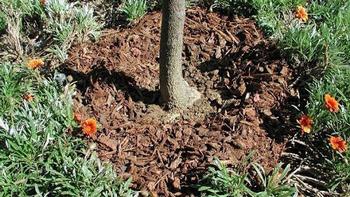How to Manage Clay Soil
-
It’s a familiar Marin County complaint: garden soil that’s hard as a rock, looks like cracked earth when it dries, and holds water like a bucket. Fortunately, there are ways to manage this common issue. The first is to choose plants that thrive in clay soil. Yes, they do exist! These include some of California’s beautiful native plants such as toyon (Heteromeles arbutifolia), bush monkeyflower (Diplicus aurantiacus),
 Clay soil is a familiar Marin County complaint. Photo: pixabay
Clay soil is a familiar Marin County complaint. Photo: pixabayCalifornia redbud (Cercis occidentalis), and sagebrush (Artemisia california). Another quick fix is to construct raised beds over areas with clay or other problematic soil and backfill with fresh, new soil. You can also take steps to improve your existing soil. Here’s how.
Use a spading fork to break up clods Use a spading fork to dig up moist clay soil. Photo: Envato Elements
Use a spading fork to dig up moist clay soil. Photo: Envato ElementsDig up moist clay soil with a spading fork, not a shovel. Break up large clods with the side of the fork and expose other clods to the sun and air. After they’ve dried and crumbled, wet them down with a light spray of the hose to soften them, and then rake them when dried again. This drying-wetting-raking combination should allow you to break up most of the clods. Once this is achieved, the important step of incorporating organic material can begin.
Amend with organic material
Blend two to three inches of organic matter into the upper several inches of clay soil. Organic matter is any material originating from living material that has died and decayed. Good choices include animal manure, green plant material, compost, and/or leaf mold.
Compost is an excellent soil amendment for clay soil because it helps limit compaction, control soil temperature, promote the growth of microorganisms, and releases small amounts of nitrogen and other nutrients.
Manure is another good option.
Dried animal manure supplies nutrients to plants and microorganisms and helps to aerate the soil. Any garden supply store will stock various manure types with application rates posted on the bag. Fresh cattle manure should be applied in fall or winter. Work the manure in right after spreading as this helps decompose the manure and lessen odors.
Some organic materials, including peat moss, straw, sawdust, rice hulls, and shredded bark, are often not as effective at improving clay soil because they decompose very slowly. When first blended into soil, they will actually compete with plants for available nitrogen.
Grow a cover crop Clover is a common cover crop. Photo courtesy of UC Regents
Clover is a common cover crop. Photo courtesy of UC RegentsCover crops consist of fast-growing plants that are grown from seed during fallow times in a vegetable garden. Cover crops are temporary plantings, usually sown in the fall, that add organic matter and protect soil from wind and water erosion. When the soil warms up in the spring, work the cover crop into the soil as deeply as possible.
Decomposed cover crop materials provide nutrients directly into the soil, thereby increasing biological activity, water filtration and soil tilth. Legumes such as fava beans, soybeans, crimson clover, red clover and hairy vetch are particularly valuable to Marin growers because they add nitrogen to the soil. Roots improve the tilth more than the tops of plants. Fine grasses and clover roots work on the upper six to twelve inches; alfalfa and sweet clover have taproots that extend deeper. When they die and rot, the roots leave channels for water and air movement in the soil.
Add a layer of mulch Mulch improves soil quality, among other benefits.
Mulch improves soil quality, among other benefits.Mulching is the application of organic or inorganic matter (such as stone) on the soil surface. A two-inch layer of mulch helps soil retain water, suppress weeds, moderate temperature, and prevent soil compaction. In addition, mulches decompose slowly thereby adding organic matter over a longer period, providing an excellent way to continually add organic matter.
Avoid compaction
Many gardeners, anxious to get into their gardens in early spring, work their soil when it is still too wet. Soil should not be dug until it is sufficiently dry enough to crumble when worked and has reached a temperature of 50 degrees. Soils high in clay content are easily damaged if worked when wet. Foot traffic and heavy equipment crush the soil's pores, which limits plant's roots access to nutrients, air and water. Clay soil retains nutrients but, because of its fine particles, has less pore space so the soil can become compacted. Plants become dwarfed and starved for nutrients, water and air.
The health of your soil determines the health of your plants. The mantra of the UC Marin Master Gardeners - "compost, compost, compost, mulch, mulch, mulch" - rings true year after year. The best way to amend the soil's structure and to provide oxygen, moisture and nutrients is to add moderate amounts of compost or a cover crop and top dress with mulch. Follow these recommendations and with time, your garden soil and the plants you grow will reward you with beauty and bounty.Original articles by Falih K. Aljibury for the UC Vegetable Research and Information Center and by Martha Proctor for the Marin IJ.
Edited for the Leaflet by Marie Narlock




